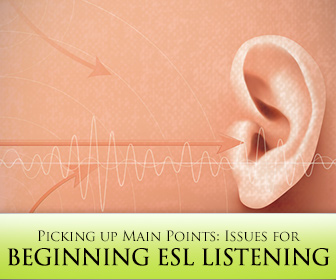“Let’s See…” Key Phrases for ESL Listening


This is strange as it’s supposedly one of the “receptive” skills that precedes the more “productive” skill of speech: that is, a speaker “produces” and a listener “receives” language. In child development, infants will listen to their families for a long period of time and then begin to speak. So because it seems in some ways to precede speaking, listening should be easier. However, I actually find listening to be one of the most difficult tasks as a second language learner. There may be a number of reasons for this:

Often languages are not phonetic. French, one of my second languages, is especially nonphonetic, the spoken portion often widely unmatched to the written, with sometimes the entire last syllable of words dropped off in speech. For literate adults, who typically are introduced to the written form of vocabulary first, it may be especially difficult to achieve this connection between the print version and spoken version of the language, hence making listening comprehension difficult.
It’s very difficult to parse out individual words and phrases to understand the stream of online speech production, as many languages, English included, connect words and emphasize and reduce specific words in phrases. While to the native speaker then, the perfectly comprehensible “What do you do?” to the nonnative beginner might sound closer to “whaduhyahduh?”--or an incomprehensible string of syllables.
All languages have their spoken forms that are not taught in classrooms because they are deemed nonstandard or “slang,” not academic, too specific to a particular place and time, perhaps not even polite. Once, for example, when I left a wake-up call in Paris, the front desk clerk responded with something that sounded like “dahcour.” I was dumbfounded, and he repeated the phrase, and then I could picture it as “d’accord,” probably meaning “of accord,” as in “I’m in accordance with you,” or put simply, “okay.” This was not something that had ever been taught to me in a classroom (although I knew “Ca va” for “okay”). Teaching this nonclassroom language that is actually used by native speakers of the language in everyday conversation is therefore critical to beginning listening classes.

Many students simply don’t listen to their second language very much, as they are not around native speakers of the language very much, and so of course they have problems with listening comprehension. Therefore, simply playing taped conversations having students listen to a dialogue between two class members or the teacher and a student and seeing how much students understand, walking them through or reviewing the conversation as necessary, is a valuable use of class time.
Some words and have phrases occur over and over in every day conversation and fulfill specific functions, such as greeting others, saying good-bye, discussing family matters, discussing current activities in one’s life, and so on. If students know these words and phrases, then they are more likely to get the general direction of a conversation. For example, if they recognize the phrase “Oh, by the way, I wanted to ask you--” or “Well, I should be going now,” as an invitation to enter a conversation and a desire to end it, respectively, this will help students in the task of managing conversations and understanding conversation/social cues in their new language, and this helps enormously.
In addition, being able to just pick out a few target words in a conversation between two speakers in a second language can help the listener understand the conversation. For example, in listening to a group of Spanish speakers in my class engaged in conversation, if I pick out the words “libre” and “costo,” I can surmise that the students are discussing the price of their textbooks, in all likelihood, even though I don’t speak Spanish at all well. Bringing in simple taped conversations then, playing them for students, and then asking them what words they understood and then what they think the conversation is about, is a great starting place for more in depth conversation.
Another good exercise is, again starting by playing a taped conversation, is to then ask students which words seemed to be “highlighted” with special stress and/or repetition and this will probably signal the main topic of a conversation.
Most of conversation language, at any rate, exists in predictable patterns with predictable language: for example, the opening (e.g., “Hi, how’s it going! How’s the family?), raising of and addressing the main points (Oh, if you’ve got a minute, I wanted to talk to you about--“) and the leave taking (“Sorry, got to run! Let’s get together soon.”) Teaching students these patterns will help students predict which direction a conversation is heading and be able to follow it better.
The parties involved in the conversation, the place, and the situation will often give clues on what a conversation is about as language occurs in context, not in isolation. A conversation in a fine restaurant as opposed to a ballpark, for example, will contain different language related to situations.
But by students training themselves to listen for the main ideas, signaled through language use, students can begin to pick up on the main points of a conversation, laying the foundation for more advanced comprehension.